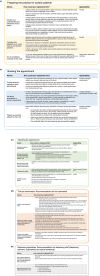Autism-friendly eyecare: Developing recommendations for service providers based on the experiences of autistic adults
- PMID: 35315935
- PMCID: PMC9313607
- DOI: 10.1111/opo.12975
Autism-friendly eyecare: Developing recommendations for service providers based on the experiences of autistic adults
Abstract
Purpose: People with autism face significant barriers when accessing healthcare services. Eye examinations present unique challenges. Accessibility of this healthcare sector for people with autism has not been investigated previously. The aim of this research was to investigate eye examination accessibility for autistic adults and produce recommendations for autism-friendly eyecare.
Methods: Two qualitative studies were conducted. In Study 1, 18 autistic adults took part in focus groups to elicit their eye examination experiences. Transcripts of the recorded discussions were thematically analysed. Study 1 findings were used to design autism-friendly eye examinations for autistic adults. These were conducted in Study 2. Twenty-four autistic adults participated in these examinations, during which they were interviewed about their experience and how it might be improved by reasonable modifications. Audio recordings of the interviews were content analysed.
Results: Knowledge of what to expect, in advance of the eye examination, could greatly reduce anxiety. Participants liked the logical structure of the examination, and the interesting instrumentation used. However, the examination and practice environment did include sensory challenges, due to lights, sound and touch. Changes in practice layout, and interacting with multiple staff members, was anxiety provoking. Participants expressed a need for thorough explanations from the optometrist that outlined the significance of each test, and what the patient was expected to do.
Conclusion: A number of accessiblity barriers were identified. These suggested that UK eye examinations are not very accessible for autistic adults. Barriers began at the point of booking the appointment and continued through to the dispensing of spectacles. These caused anxiety and stress for this population, but could be reduced with easy-to-implement adaptations. Based on the findings, recommendations are presented here for the whole eyecare team which suggest how more autism-friendly eye examinations can be provided.
© 2022 The Authors. Ophthalmic and Physiological Optics published by John Wiley & Sons Ltd on behalf of College of Optometrists.
Conflict of interest statement
None.
Figures

References
-
- Green D, Chandler S, Charman T, Simonoff E, Baird G. Brief report: DSM‐5 sensory behaviours in children with and without an autism spectrum disorder. J Autism Dev Disord. 2016;46:3597–606. - PubMed
-
- Simmons D, Robertson A, McKay L, Toal E, McAleer P, Pollick F. Vision in autism spectrum disorders. Vision Res. 2009;49:2705–39. - PubMed
-
- World Health Organization . International statistical classification of diseases. 11th Revision ed. Geneva: World Health Organization; 2021.
-
- American Psychiatric Association . Diagnostic and statistical manual of mental disorders. 5th ed. Arlington: American Psychiatric Association; 2013.
-
- Brugha T, Cooper S, McManus S, Purdon S, Smith J, Scott F, et al. Estimating the prevalence of autism spectrum conditions in adults: extending the 2007 adult psychiatric morbity survey; 2012. [Accessed 14 March, 2022]. Available from: http://www.wecommunities.org/MyNurChat/archive/LDdownloads/Est_Prev_Auti...
Publication types
MeSH terms
Grants and funding
LinkOut - more resources
Full Text Sources

